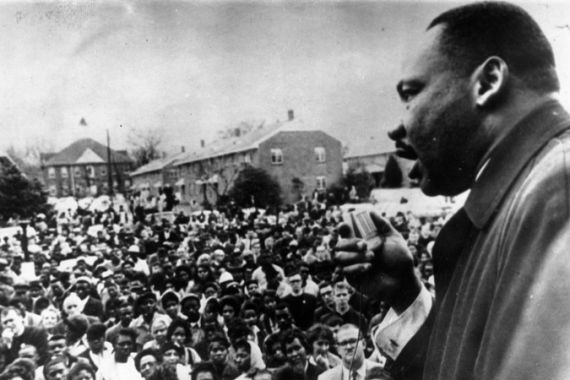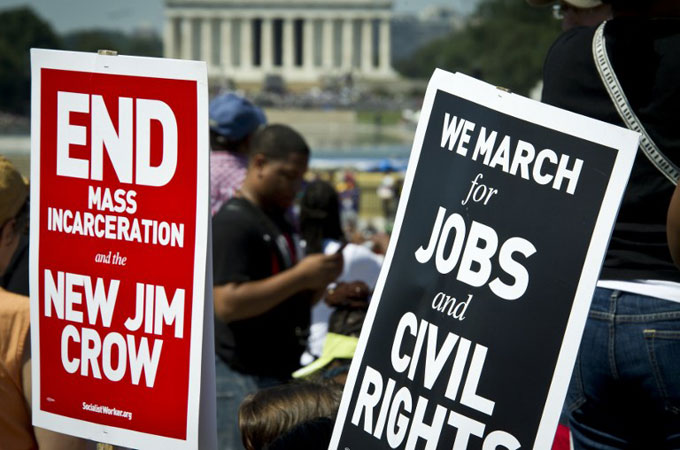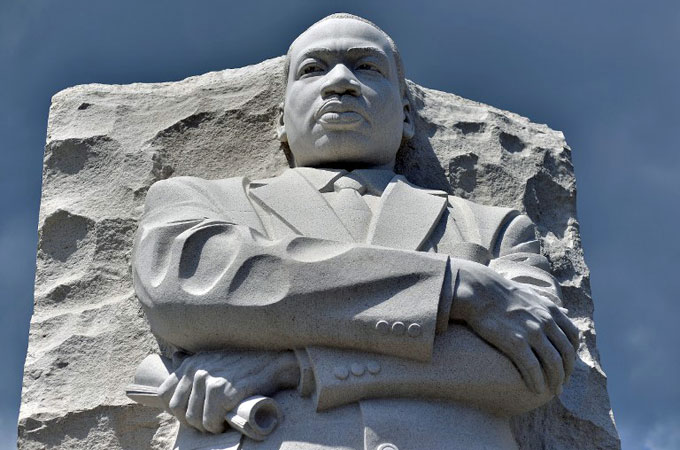The story behind King’s famed jail letter
The ‘Letter from Birmingham Jail’ created the moral blueprint for the civil rights movement.

In April 1963, Clarence Jones, the legal counsel for Martin Luther King Jr, took scribbled bits of newspaper and toilet paper he had smuggled out of King’s Birmingham jail cell and passed them to Wyatt Tee Walker, King’s chief of staff. In turn, Walker handed them to his secretary, Willie Pearl Mackey King, so she could type them up.
By the time she was 22, Mackey had seen racial prejudice at its worst. According to historian S Jonathan Bass’ account in “Blessed Are the Peacemakers”, she had quit her job as a counter waitress at a popular Emory University lunch spot after a group of white students in blackface took a photograph inside the eatery. She later quit another job in the food-service department of an Atlanta hospital after an elderly black coworker was denied treatment for a heart attack because it went against hospital policy to treat blacks.
Keep reading
list of 4 itemsBirth, death, escape: Three women’s struggle through Sudan’s war
Does Israel twist humanitarian law to justify Gaza carnage?
Vatican denounces gender-affirming surgery, gender theory and surrogacy
Now she was typing up a letter that would challenge the cultural acceptability of racial prejudice – even if the greater meaning of the task had yet to dawn on her.
 |
| Demonstrators marked the 50th anniversary of the March on Washington earlier this week [AFP] |
“[King] was so anxious to get a response to [the clergymen]”, Mackey King says. “If you have a story you really need to get out and the boss needs you to get it out, you work hard to get it out. The importance of the letter didn’t mean anything to me. Something needed to be done.”
The result? Letter From Birmingham Jail, the guiding force of the civil rights movement, celebrated this month on the 50th anniversary of the March on Washington.
“There is a need for us to understand and appreciate what it took to get the letter, to get the words out of jail and make them available to the public,” says Democrat John Lewis, who represents Georgia’s 5th District in the US Congress – and is the last surviving speaker from the March on Washington. “And for it to be written, typed and sent out, it is a powerful, powerful message not just to the American religious committee but to the world religious committee and community at large for them to understand that there comes a time when someone like Martin Luther King Jr is moved by what I call the spirit of history.”
The process of turning scraps of jailhouse newspaper and toilet paper into Letter From Birmingham Jail remains, in itself, a seminal achievement.
The decision for King and the movement to go to Birmingham in early April 1963 to initiate civil disobedience was no accident. After more than a year trying to desegregate public facilities in Albany, Georgia, little had changed in the city’s schools and parks. The New York Herald Tribune called the Albany campaign “one of the most stunning defeats of King’s career”. The movement needed to be repositioned.
But in Birmingham, King was served with an injunction that forbade him from organising nonviolent protests pushing for desegregation. Bull Connor, the infamous Birmingham commissioner for public safety, contended that the continued protests would “cause incidents of violence and bloodshed” as well as “irreparable injury to persons and property”. Leading a nonviolent protest, King was promptly arrested, ending up in jail during what was an uneasy time for the movement.
The uneasy mood in Birmingham took its toll on King’s staff. “I didn’t think I’d see my wife or children anymore,” Walker says. “I didn’t see how I could get out of there alive.”
With hundreds of teenagers in jail for peacefully protesting segregation, Jones, as King’s legal counsel, had to deal with angry parents who demanded to know when their children would be bailed out. In King, Jones knew he had an ace in the hole who could be a powerful fundraising tool for bail money.
But when Jones went to raise the issue with King in his dark jail cell devoid of a mattress, something else happened. Almost dismissive of what Jones needed at the time, King revealed that there was an even more pressing issue on his mind.
“Martin, do you understand what I just told you?” Jones asked.
King responded, “Yes, but did you see this?”
Pulling out a copy of the April 13 edition of the Birmingham News, an apoplectic King pointed to the full-page ad from eight white clergymen, essentially telling King, the outside agitator who refused to put a halt to the protests, to leave. To them, King’s “unwise and untimely” campaign had no place in Birmingham. They went on to praise the calm nature of the city’s law enforcement in the ironically – and tragically – titled “Call for Unity”.
“I have to answer this,” King told Jones.
It was then that Jones realised that King had already begun to respond to the clergymen.
“I look around and see every blank space and edge of every old newspaper there had been written on, including paper towels,” Jones says.
Making the most of the little sunlight that trickled through the bars of his cell, King wrote furiously from his encyclopaedic memory, quoting the Bible, Shakespeare, Voltaire and theologians, on any scrap of paper he could find. The tide of indignation that came from the clarity of his thinking those few days in jail produced what amounted to the black community’s declaration of independence.
King needed more paper, and he also needed what he had written to be transcribed. Jones, who visited King twice a day in one of his tailored suits, would smuggle paper in and out using the inside pocket of his jacket. Since the jail personnel saw him every day, they didn’t feel the need to pat him down.
How Mackey King found her spot in this important history is all the more curious, given that she was, by her own admission, a terrible typist.
“I’m still not the greatest typist in the world,” she says with a quiet laugh. “Working for Walker, you had to get it right, even if it killed you. He was not easy to work with. I was scared to death of the man.”
A strategist and mediator in King’s inner circle at the time, Andrew Young was still relatively green on the campaign front. Like others in King’s inner circle who were working on the letter’s production, Young was solely focused on the transcription. To him, nothing else mattered.
“I sat there and watched her do it,” Young says. “She would call me over and ask: ‘Andy, what is this word?’ She’d say: ‘Dr King can talk, but he sure can’t write.’
 |
| It has been 50 years since MLK’s celebrated ‘I have a dream’ speech [AFP] |
“We were so focused on the translation and getting what he said right that we forgot the importance of the paper.”
King’s less-than-stellar handwriting was a real challenge for Mackey King, who was racing against the clock. “It was not clear. It was almost like chicken scratch. My vocabulary was certainly not something that could have helped me figure out what [King] was saying. I typed what I thought I saw. Sometimes that would be right, and other times it wasn’t right. His handwriting was terrible. You just couldn’t figure it out.”
Some of the scribbled notes from King were in such bad shape that several of them were thrown in the trash. At the time, King’s staff didn’t make it a habit of keeping or archiving his material, so for Mackey King, the act of tossing the illegible, beat-up notes wasn’t to be second-guessed.
“I tell you what,” Mackey King says, “after looking at them for so long, I had no reservation in throwing them away whatsoever… To me, it would have made no sense to keep [those scraps]. Everybody wants to criticise, but [those scraps] didn’t have the same meaning.”
In the days and weeks during the letter’s construction, Mackey King would work deep into the night to transcribe King’s writings. After not sleeping for two days and two nights, physically and mentally spent, she passed out with her head on her typewriter. Walker moved Mackey to a nearby couch, sat at the typewriter and finished typing the letter himself. Later, historians began to wonder whether Walker, whose own fiery, verbose sermons became legend, had any individual influence on the letter’s wording.
“I was just doing a job,” says Walker. “I didn’t edit so much as I translated it. Dr King’s thoughts were clear.”
The mood in Birmingham, along with the increasing anger among parents of the jailed teens, had a couple of members of his inner circle questioning why King spent so much time responding to the clergymen.
“I didn’t really pay attention to the letter until almost a week later,” says Jones. “When I was reading it quietly somewhere, I said to myself: ‘Oh, my God, this is unbelievable.'”
The letter had something of a barbed quality and did not help curb the violence by Birmingham police during the protests. But King and his inner circle were patient.
Then on May 2 of that year, Birmingham’s version of D-Day happened, with Birmingham police wielding water hoses and unleashing German shepherds on nonviolent protesters. The disturbing images of black men and women being doused with water, and of dogs viciously attacking young protesters, were soon disseminated worldwide. The media coverage surrounding the photos brought attention to the letter and helped push the movement toward Washington, DC. In the summer of 1963, about 250,000 people would join the March on Washington. King was front and centre, representing the grander scope of civil rights, and that’s how those who helped produce and support Letter From Birmingham Jail preferred it.
“Social-change agents function better when they’re under the radar,” Young says. “Everybody could be under the radar, but Dr King. I think we saw ourselves as supporting his vision and his mission. Nobody needed to know who we were.”
If you’re in the US, check out America Tonight on Al Jazeera America for more on the 50th anniversary of the March on Washington. You can keep up with America Tonight on Twitter: @AmericaTonight
Follow Timothy Bella on Twitter: @TimBella